Story and Photos By Roberto Motta unless otherwise noted.
NEW! Scroll down for the Italian language version.
Most vintage car enthusiasts are aware of the famous Scuderia del Portello, named after the town near Milan where Alfa Romeo was born. Its distinctive shield has been seen all over the world on a great variety of Alfa Romeos. To learn more about the Scuderia del Portello and its president Marco Cajani, we had a meeting with him in the team headquarters in the town of Seregno. We found that Cajani is an inexhaustible source of ideas, a passionate collector and a good driver. During his life with cars, thanks to his organizational skills and an innate charisma, he was able to bring the world famous Scuderia del Portello to new levels of excellence. A graduate in architecture, Cajani is responsible for recovery and building restoration. But the Alfa Romeo is his great passion, a passion that binds him hand in glove with the Scuderia del Portello.
But who is Marco Cajani and what is his background? We’ll let him tell his story without interruption:
I went to the races as a gentleman-driver, and I was enrolled by the team ‘Squadra Corse Meda’, founded by my friend Giancarlo Galimberti from the town of Meda, a little town near Seregno. After the first few races with the GTV I could not resist the charm of the GTA, and I bought a car prepared by the Facetti brothers. Again I used the car for my daily commute and for use in the race.
Afterwards, through the Facettis, I bought a Lancia Fulvia HF Group 4 1300 that was used by a driver who was living in Bergamo. The car was red and black, featuring a livery that was like a chessboard, the same look that has marked all my cars and that, sometime later, I put in the logo of Scuderia del Portello.
The Fulvia was the first car that I used only for racing, although in reality, I still had to drive it to reach venues around the country. I remember I bought two Dunlop race tires in Switzerland, which I had loaded into the back seat, I mounted them on the car before the race, and then, when I ended the race, I re-mounted my road tires to drive back home. I did so until ’71, when I had a bad accident that seriously compromised the car and prevented me from preparing her for the Coppa Carri. It was then that unbeknown to me my family sold the car! It was a bad time and because I could not drive a racing car and be among the other drivers, so I stopped attending the races.
Years later, in ’83, when I was busy restoring a workshop in Seregno, my attention was drawn to an Alfa Romeo Giulietta SS colored with the Scuderia del Portello livery.
I later learned that the team was run by Luca Grandori, and that the car was technically maintained by Mirabella Racing. I bought this car at a modest price. I knew Grandori, and became a member of the team and soon found myself catapulted into the European Classic Cars Championship.
At that time, participation in competitions was possible because it was not as expensive as it is today. Scuderia del Portello was an official team, which was reserved only for the historical cars Alfa Romeo. We were supported by the Alfa Romeo Company. As a Scuderia Portello driver, our commitment was only to bring the car to Mirabella Racing, so that they could transport the cars to the track, and when the event was concluded to bring the car home.
My car was technically prepared by Giancarlo Galimberti, at the Galimberti’s workshop in Meda. For me it began a new life: I was glad to be back racing with the cars that I had left fifteen to twenty years before. Later I bought the Giulietta SS and with this car I won the European championship in 1986.
At the same time, the Scuderia del Portello was having an internal crisis due to the fact that its president, Grandori, preferred to engage in the implementation of Club Italia. So, I bought a Lotus and continued to run in the European championship with the objective to achieve a certain level of expertise. In 1989, after Fiat bought Alfa Romeo, Scuderia del Portello had a change of management and during a rather turbulent vote, installed a new management team and I became the President.
From that moment I decided to commit to improving the image of the Scuderia del Portello. The first step was to improve the organization, even including the transportation of cars to sports venues, participate only in national events and to give maximum visibility to the Scuderia. See Inside Scuderia del Portello
I made an agreement with Alfa Romeo; I purchased two big trucks for the transport of cars and, in turn, Alfa Romeo entrusted the Scuderia del Portello to take care of all the racing cars for transportation to the track. In the mean time the Scuderia del Portello became the link between the culture of vintage sport cars and the technological research of modern sport cars.
I was the team’s president until ’91, when Dr. Chiavelli took over. He remained in office until ’94, when I was re-elected president and still hold that office.
My policy was (and is) to have an official team at all levels. Personally I drew the current logo, and it was designed under the Fiat management era. The team officially became the team of all owners of Alfa Romeo racing cars, historic and modern.
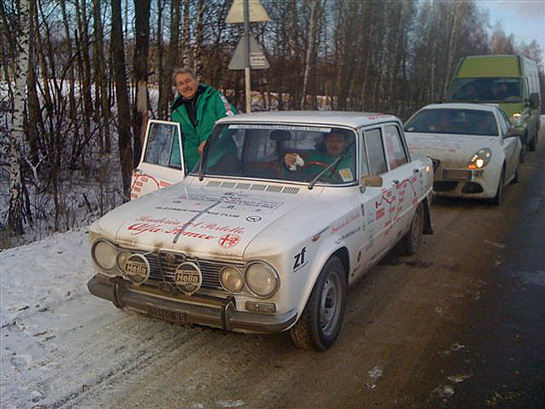
Shanghai to Milan was accomplished in 2010. Photo courtesy Scuderia Portello. (click photo to read full story)
Then we began to participate in the great raids as the London to Sydney, the London to Acapulco and the Carrera Panamericana. The team had thus crossed the borders of the European territory to become known around the world. Today, we have affiliations with other clubs from Japan, Brazil, Switzerland, Portugal, Belgium, Germany, England, and South America. Over time, Scuderia del Portello has won 18 European titles, participated in and won many races and has about 300 members. Our members are participating in competitions all over the world.
We have also revived the old tradition of Alfa Romeo to gather all the drivers who during the year won at least one race with an Alfa at the awards ceremony at Arese. (The next awards ceremony will be, on 4 June, at the Monza track during the ‘59°Coppa Intereuropa’ because the Alfa Romeo Museum is closed. )
With the passage of time our members became older, and this decreased the participation of our historical cars in the races. Therefore in 2000 we opened the activity of the Scuderia for gentlemen drivers competing in cars with Alfa Romeo’s new generation, establishing the Trofeo Alfa Romeo 156.
Year after year, sport with modern cars has become increasingly expensive and Alfa Romeo was engaged with Alfa Corse and N. Technology, a reality that no longer exists. Today the Scuderia del Portello is the only team in the world where there are only Alfa Romeo cars.
Over the years, we have become dedicated to endurance races like the 24 hours of Nurburgring. Today, many fans are asking us to participate in endurance events such as Spa, Nurburgring and so on. First, it’s a significant economical commitment that we cannot tackle alone and it requires the contribution of Alfa Romeo or the official support of the Alfa Romeo sponsors. Our decisions about the programs are influenced by Alfa Romeo’s choice.
Then in addition, Scuderia del Portello have always worked with a large deployment of economical resources, technicians, trucks, cars and drivers to assure itself and the company a big “image” in return.
We have participated in events such as Goodwood and Le Mans, involving famous drivers as Facetti, Merzario and Munari, and we gave many drivers the opportunity to compete and have fun with the cars of their youth. But everything is expensive. That’s why we need help of an economic nature, even if not directly, at least by the sponsors of Alfa Romeo.
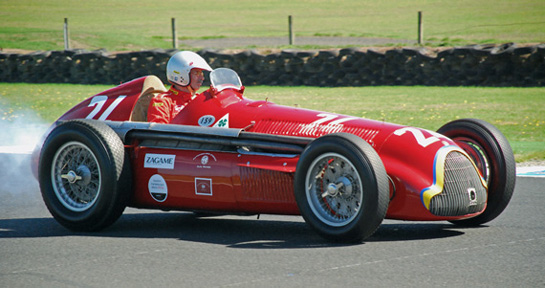
Alfa Romeo 159 from the Alfa Museum was the star of the Phillip Island Classic. But now we know the reason for the use of advertising on Museum cars. Photo by Vince Johnson.
We would like to reach an agreement with Alfa Romeo that allow us to take part in the most important races in the world. We could also participate in these races with a car and driver that come from the various nations, thanks to the involvement of our offices abroad, while the great support and enthusiasm of our members allows many things do occur.
In other words, Scuderia Portello has a proven and efficient structure, and we can make this structure available for Alfa Romeo, with whom we would like reach an agreement for future programs.
Today the “history” of the Milanese brand is supported by Automobilismo Storico (the organization created by Pasquale Oliveri, that has become a benchmark), the Registo Storico Alfa Romeo (RIAR) and by Scuderia del Portello. The Historical Register, operates for the cultural preservation of Alfa Romeo, and has the direct support of members, while the Scuderia del Portello is the effective presence on the racetrack of historic Alfa Romeo racing cars.
In the Alfa Romeo Museum rooms, at Arese there are the most beautiful cars in the world, but they cannot take part in real competitions race: the cars are used only in demonstration runs. However, Scuderia del Portello may participate in all the races, thanks to the passion, boldness and willingness of its members, and deploy cars like the SS, SZ, GTA 33 and many others.
In the most important races like the 24 Hours of Le Mans, thanks to our members’ cars, the Alfa Romeo is the only marque in the world to be able to field a car in each group.
Thanks to this wealth of cars we are planning the 24 Hours of Nurburgring and the Carrera Panamericana in addition to participation in various Raid of Peace and Brotherhood that will function in the Expo every year starting from a different country.
I think that Scuderia del Portello is a important parts of Alfa Romeo and it is the only team in the world to be under the auspices of the actual company. Scuderia del Portello has become the universal symbol of Alfa Romeo at the races and it is respected because it represents a glorious history and heritage.
Schedule
Intereuropa Cup at Monza
(Ceremony of Champions Alfa Romeo) 3 / 5 June
– 24 h Le Mans Classic 11/12 June
– 24/26 June Dijion Classic
– Silverstone Classic 22/23 July
– Goodwood Festival of Speed July 30/31
– Gran Premio Nuvolari 15/18 September.
– Goodwood Revival Meeting 16/18 September.
– Historique Portimao Festival 21/23 October
– Tour of Italy car 25/30 October
See Inside Scuderia del Portello
More about the Scuderia and its cars and events can be found on their website. www.scuderiadelportello.org/
In Italian
Per conoscere meglio la Scuderia del Portello e il suo presidente Marco Cajani, abbiamo visitato la sede della scuderia a Seregno una cittadina a pochi chilometri dal mitico circuito di Monza. Cajani è una fonte inesauribile di idee, un appassionato collezionista e un buon pilota. Nel corso della sua vita automobilistica, grazie alle sue capacità organizzative e ad un innato carisma, è riuscito a portare al suo massimo splendore una delle scuderia più amate nel mondo, la Scuderia del Portello. Laureato in architettura, si occupa di recupero e restauro edilizio. La sua grande passione è l’Alfa Romeo, una passione che lo lega a doppio filo con la Scuderia del Portello.
Ma chi è l’uomo Cajani e qual è la sua storia automobilistica?
Il mio ingresso nel mondo delle auto e delle competizioni è avvenuto nella seconda metà degli anni ’60. Fu facilitato anche dal fatto che mio cognato era proprietario di un concessionaria Alfa Romeo. Acquistai un’Alfa Romeo GT veloce di colore argento da utilizzare quotidianamente per recarmi al lavoro. Poi, con la stessa vettura e un gruppo di amici, il fine settimana raggiungevo il campo di gara.
Il mio debutto in gara avvenne nel ’67 in occasione di una gara in salita, la Biella-Graglia. Ricordo molto bene questa gara, anche perché venni rimproverato duramente dai commissari, per non aver indossato il casco durante le prove.
Mi avvicinai alle gare come gentlemen-driver, associandomi alla scuderia ‘Squadra Corse Meda’; una piccola scuderia fondata dall’amico Giancarlo Galimberti. Dopo le prime gare con la Giulia, non riuscii a resistere al fascino della GTA, e comprai una vettura preparata dai fratelli Faccetti. Anche in questo caso utilizzavo la vettura sia per i miei spostamenti quotidiani, che per l’impiego in gara.
Tempo dopo, tramite Faccetti acquistai da un pilota di Bergamo una Lancia Fulvia HF Gr.4 1300. La vettura era rossa e nera, caratterizzata da un livrea che presentava una serie di scacchi, la stessa grafica che ha caratterizzato tutte le mie successive vetture e che ho poi inserito nel logo della Scuderia del Portello.
La Fulvia fu la prima vettura che utilizzai solo per le corse, anche se in realtà, non avevo ancora un carrello per trasportarla, e raggiungevo i campi di gara sparsi in tutto il Paese, con la stessa vettura che avrei poi utilizzato in gara. Ricordo che acquistai due pneumatici Dunlop in Svizzera, che caricavo in macchina al posto del sedile posteriore e che montavo al posto delle gomme anteriori una volta raggiunta la destinazione. Terminata la gara, le smontavo, le rimettevo nell’abitacolo e rimontavo le gomme “da strada” per tornare a casa.
Feci così fino al ‘71, quando in gara ebbi un grave incidente che compromise seriamente la vettura e che mi impedì di prepararla per la Coppa Carri. Fu allora che a mia insaputa i miei familiari vendettero la vettura.
Fu un brutto periodo e, non potendo essere tra i protagonisti, smisi di frequentare l’ambiente e mi disinteressai delle gare.
Anni dopo, nell’83, mentre ero impegnato nell’edificazione di una carrozzeria a Seregno, la mia attenzione fu attirata da un’Alfa Romeo Giulietta SS che si trovava nella stessa carrozzeria e che aveva i colori della Scuderia del Portello. Seppi poi che la scuderia era gestita da Luca Grandori e, che la vettura era curata meccanicamente dalla Mirabella Racing.
Comprai questa vettura a un prezzo modesto, conobbi Grandori, divenni socio della scuderia e in breve tempo mi ritrovai catapultato nel Campionato Europeo Auto Storiche. In quel periodo, la partecipazione alle competizioni era possibile a cifre contenute perché la Scuderia del Portello era un team ufficiale, riservato alle auto storiche Alfa Romeo. Eravamo sponsorizzati dalla Casa, il nostro impegno di piloti era solo quello di portare la vettura alla Mirabella Racing che si occupava di portarle sui campi di gara e di riportarle a casa.
La mia vettura era seguita tecnicamente da Giancarlo Galimberti di Meda.
Per me iniziò una nuova vita, ero contento di essere ritornato a correre con le vetture che avevo lasciato quindici-venti anni prima.
Dopo la Giulietta SS acquistai la SZ con la quale vinsi il campionato Europeo nel ‘86. Nello stesso periodo, la Scuderia del Portello visse una crisi dovuta al fatto che il suo presidente, Grandori, preferì impegnarsi nella realizzazione del Club Italia.
Così, comperai una Lotus e continuai a correre nel campionato Europeo con l’obiettivo di ottenere risultati di un certo rilievo.
Nell ’89, dopo che la Fiat acquistò l’Alfa Romeo, all’interno della Scuderia del Portello ci fu un cambio di gestione e, nel corso di una votazione piuttosto turbolenta, si insediò un nuovo gruppo dirigente del quale divenni il presidente.
Da quel momento decisi di impegnarmi a migliorare l’immagine della Scuderia. Il primo passo fu quello di migliorarne l’organizzazione, uniformare il trasporto delle vetture sui campi di gara, partecipare solo a manifestazioni nazionali e dare la massima visibilità alla scuderia.
Quindi, feci un accordo con l’Alfa Romeo nel quale mi impegnavo ad acquistare due bisarche per il trasporto delle vetture e, in cambio, l’Alfa Romeo si impegnava ad affidarmi le vetture per il trasporto.
Rimasi presidente della scuderia fino al ‘91, quando subentrò il dottor Chiavelli che rimase in carica fino al ‘94, quando fui rieletto presidente. Da allora mantengo questa carica.
La mia politica era (ed è) quella di avere una scuderia ufficiale a tutti i livelli.
Concordai il cambio del marchio con l’ingegnere Testore, manager Fiat. Disegnai personalmente l’attuale logo, e la scuderia divenne ufficialmente la scuderia di tutti i possessori di vetture Alfa Romeo da competizione, storiche e moderne.
Iniziammo quindi a partecipare ai grandi Raid come la Londra Sidney, la Londra Acapulco o la Carrera Panamericana.
La scuderia aveva così valicato i confini del territorio europeo per farsi conoscere in tutto il mondo. Oggi, abbiamo affiliato altri Club dal Giappone, Brasile, Svizzera,Portogallo, Belgio, Germania, Inghilterra, Sud America ecc.
Nel tempo la scuderia del Portello ha conquistato 18 titoli europei, partecipato e vinto qualsiasi tipo di gara. Tuttora, raggruppa solo auto da competizione e conta circa 300 iscritti che partecipano a competizioni nelle varie parti del mondo.
Abbiamo ripreso la vecchia tradizione della Alfa Romeo incontrandoci ad Arese per la premiazione di tutti i piloti che nel corso dell’anno hanno vinto almeno un gara con una vettura del Biscione.
Con il trascorrere del tempo soci e vetture sono invecchiati ed è diminuita la partecipazione delle vetture nelle gara storiche perciò nel 2000 abbiamo aperto l’attività della Scuderia anche ai Gentlemen Driver che partecipano alle competizioni con vetture Alfa Romeo di nuova generazione. Inoltre, abbiamo costituito il 1° Trofeo Alfa Romeo 156.
Anno dopo anno, l’attività sportiva con le vetture moderne è diventata sempre più dispendiosa e Alfa Romeo era impegnata in altre realtà sportive (Alfa Corse e N. Tecnology), realtà che oggi non esistono più, mentre noi siamo rimasti l’unica scuderia al mondo in cui ci sono presenti esclusivamente vetture Alfa Romeo.
Nel corso degli anni, ci siamo dedicati alle gare di durata come la 24 ore del Nurbugring. Oggi, molti appassionati ci chiedono di partecipare a gare di durata come Spa, Nurburgring ecc. E’ un impegno considerevole che non possiamo affrontare da soli e che richiede l’apporto ufficiale della Casa madre poiché il parziale supporto degli sponsor non è sufficiente e le nostre decisioni sono influenzate dalle scelte di programma dell’Alfa Romeo. Inoltre, la scuderia del Portello è una struttura che ha sempre lavorato con un grande spiegamento di mezzi per assicurare a se stessa e al marchio un grande ritorno di immagine. Abbiamo partecipato a eventi importanti come Good Wood o Le Mans, coinvolgendo piloti famosi come Faccetti, Merzario e Munari, e abbiamo dato la possibilità a tanti piloti di competere e divertirsi con le auto della propria giovinezza. Tutto ciò ha costi elevati. Ecco perché ci serve un aiuto di natura economica, anche se non diretto, almeno attraverso gli sponsor dell’Alfa Romeo.
Vorremmo raggiungere un accordo con l’Alfa Romeo che ci permetta di prendere parte alle più importanti gare del settore; a tali gare possiamo partecipare anche con una vettura per nazione, grazie al coinvolgimento delle nostre sedi all’estero.
Tale accordo deve consentirci di curare l’aspetto programmatico e organizzativo, attività che oggi è svolta amatorialmente perché demandata alla passione dei soci.
In altre parole, abbiamo una struttura collaudata ed efficiente, che mettiamo a disposizione anche dell’Alfa Romeo con la quale ritengo si possa concordare un accordo programmatico. Oggi la storia della Casa milanese è rappresentata dall’Automobilismo Storico (la struttura creata da Pasquale Oliveri, diventata punto di riferimento impareggiabile), dal Registro Storico Alfa Romeo e dalla Scuderia del Portello.
Il Registro Storico, opera in un ambito culturale di conservazione con il supporto diretto dei soci mentre la Scuderia del Portello rappresenta la presenza effettiva sui campi di gara delle vetture storiche da competizione Alfa Romeo.
Il Museo raccoglie alcune delle vetture più belle del mondo, che però non possono prendere parte a vere competizioni.
La scuderia può partecipare alle competizioni grazie alla passione, alla disponibilità e all’audacia dei propri soci, e schierare vetture come le SS, SZ, GTA o le 33 ecc. Nelle gare più importanti come la 24 ore di Le Mans, grazie alle vetture dei nostri soci l’Alfa Romeo è l’unica Casa al mondo a poter schierare una vettura in ogni raggruppamento. Forti di questa ricchezza stiamo programmando la 24 ore del Nurburgring e la Carrera Panamericana oltre alla partecipazione a diversi Raid della Pace e Fratellanza che faremo in funzione dell’Expo partendo ogni anno da una nazione diversa.
La Scuderia del Portello è una costola importante di Alfa Romeo ed è l’unica scuderia al mondo a rappresentare una Casa. È diventata il simbolo universale dell’Alfa Romeo sui campi di gara ed è rispettata proprio perché rappresenta una Casa gloriosa.
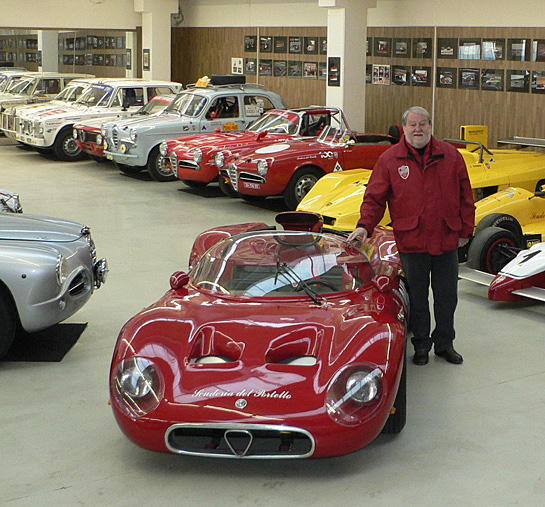
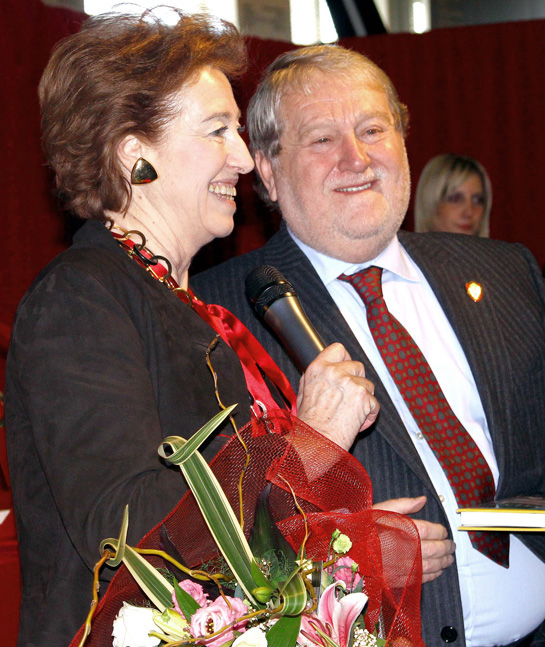
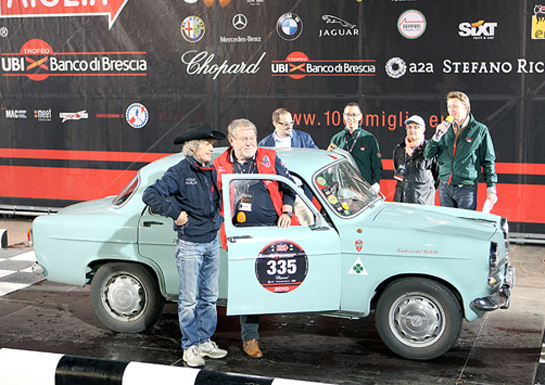
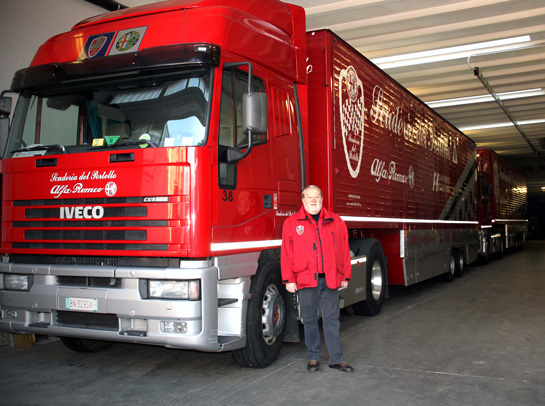
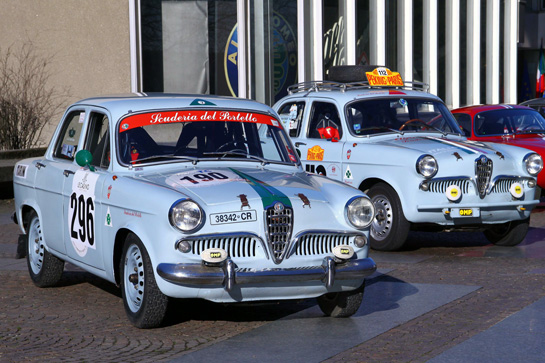
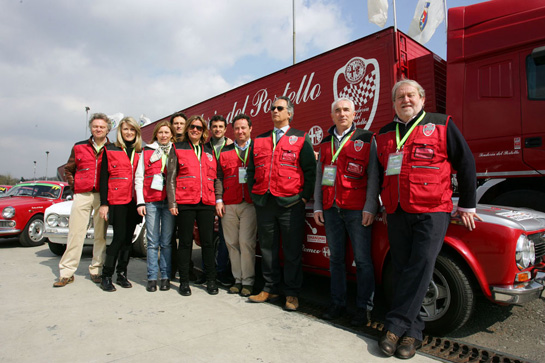
We should all be grateful to the wealthy people who use their wealth for real socially beneficial purposes, especially the preservation of old cars (and airplanes, I’d add). I don’t think they get any tax breaks for doing so.
We should be especially grateful to Marco Cajani for his passon. We are all the lucky recipients!